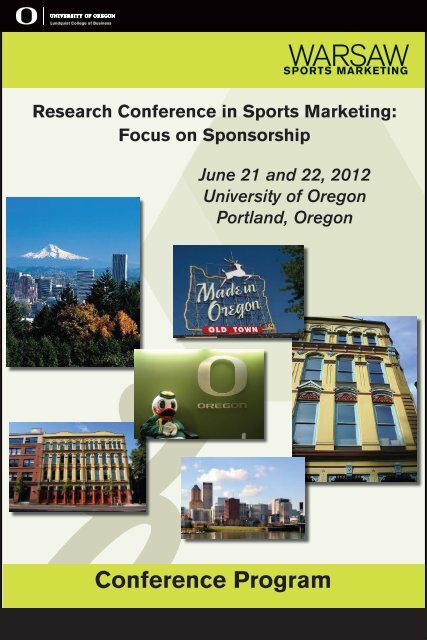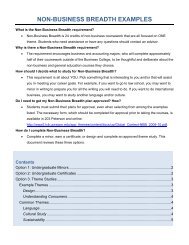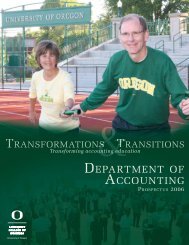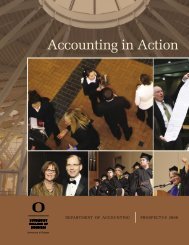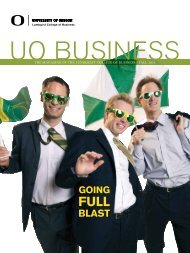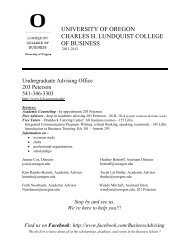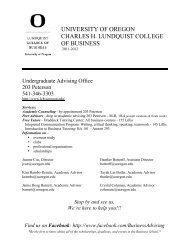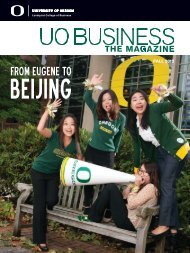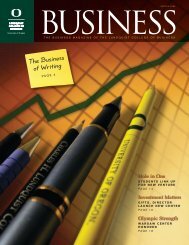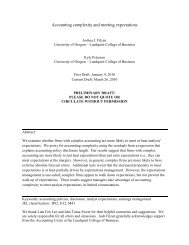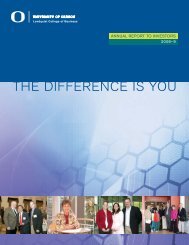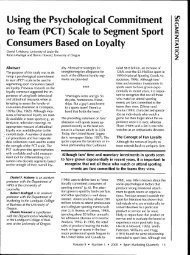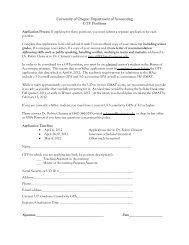Download the conference program - Lundquist College of Business ...
Download the conference program - Lundquist College of Business ...
Download the conference program - Lundquist College of Business ...
You also want an ePaper? Increase the reach of your titles
YUMPU automatically turns print PDFs into web optimized ePapers that Google loves.
Research Conference in Sports Marketing:<br />
Focus on Sponsorship<br />
June 21 and 22, 2012<br />
University <strong>of</strong> Oregon<br />
Portland, Oregon<br />
Conference Program
Research Conference in Sports Marketing: Focus on Sponsorship<br />
Warsaw Sports Marketing Center<br />
<strong>Lundquist</strong> <strong>College</strong> <strong>of</strong> <strong>Business</strong>, University <strong>of</strong> Oregon<br />
Portland, Oregon<br />
June 21 and 22, 2012<br />
Wednesday, June 20<br />
Conference Registration<br />
4:00-6:00<br />
Vintage Plaza Hotel (Lobby)<br />
Thursday, June 21<br />
Conference Registration (outside entrance to 142/144 White Stag)<br />
7:30-8:00<br />
Welcome and Continental Breakfast (142/144 White Stag)<br />
8:00-9:00<br />
David Boush, Associate Dean, <strong>Lundquist</strong> <strong>College</strong> <strong>of</strong> <strong>Business</strong><br />
Paul Swangard, Managing Director, Warsaw Sports Marketing Center<br />
Session 1 (142/144 White Stag)<br />
9:00–10:00<br />
Keynote Speaker: Anders Sundt Jensen<br />
Vice President Brand Communications, Mercedes-Benz<br />
Cars<br />
Sponsoring: A Strategic Pillar for Mercedes-Benz<br />
Brand Communications<br />
Anders Sundt Jensen, Vice President Brand Communications Mercedes-Benz Cars, presents <strong>the</strong><br />
role and importance <strong>of</strong> sponsorship for <strong>the</strong> brand Mercedes-Benz. This sponsorship strategy is<br />
based on 5 international platforms with <strong>the</strong> goal to create global brand awareness and provide<br />
access to potential customers.<br />
Break: 10:00-10:15 (142/144 White Stag)
Session 2 (142/144 White Stag)<br />
10:15-11:00<br />
Francois Carrillat, HEC Montréal<br />
Alain d'Astous, HEC Montréal<br />
Francois Bellavance, HEC Montréal<br />
Francois Eid, HEC Montréal<br />
On ‘Being There’: The Effectiveness <strong>of</strong> Sporting Event Sponsorship in On-<br />
Site versus Media Environments<br />
Discussant: Christopher Lee, University <strong>of</strong> Oregon<br />
Abstract: This paper presents <strong>the</strong> results <strong>of</strong> a field experiment where <strong>the</strong> effectiveness<br />
<strong>of</strong> field sponsorship, as assessed by sponsor recall and recognition, was compared in<br />
two radically different viewing environments: on-site and television. A series <strong>of</strong><br />
research hypo<strong>the</strong>ses concerning <strong>the</strong> effects <strong>of</strong> <strong>the</strong> viewing environment as well as <strong>the</strong><br />
interactive effects <strong>of</strong> gender, affective valence (i.e., pleasure), and affective intensity<br />
(i.e., arousal) were put forward. Forty-four hockey fans attended a pr<strong>of</strong>essional hockey<br />
game in <strong>the</strong> local team’s arena whereas forty-four o<strong>the</strong>rs saw <strong>the</strong> same game, at <strong>the</strong><br />
same time, on television. Emotion impacted sponsorship effectiveness among men but<br />
not among women. More specifically, for male spectators, pleasure decreased recall<br />
and recognition on-site relatively to television whereas arousal improved <strong>the</strong>se<br />
outcomes on-site compared to television. Implications for sponsorship practice and<br />
research are presented.<br />
Session 3 (142/144 White Stag)<br />
11:00-11:45<br />
Marc Mazodier, University <strong>of</strong> South Australia<br />
Karen Palmer, University <strong>of</strong> Adelaide<br />
Carolin Plewa, University <strong>of</strong> Adelaide<br />
Pascale Quester, University <strong>of</strong> Adelaide<br />
Being a Good Sport: Can Sponsors Use CSR to Build Their Brand?<br />
Discussant: Eric Olson, University <strong>of</strong> Colorado at Colorado Springs<br />
Abstract: In response to increasing clutter, cost, and pressure to be considered a good<br />
corporate citizen, sponsors have turned away from large, pr<strong>of</strong>essional corporate properties<br />
to community-based properties that can deliver an engaged audience and demonstrate <strong>the</strong><br />
sponsor’ s corporate social responsibility (CSR). In this paper, we conceptually develop<br />
and empirically show how community-based sponsorship may improve self-congruity.<br />
While self-congruity has been shown to act as a determinant <strong>of</strong> consumer behavior, little is<br />
known about its antecedents. In this study, we found perceived sponsor CSR image to<br />
mediate <strong>the</strong> relationship between perceived community-based sporting club CSR and<br />
consumers’ self-congruity with <strong>the</strong> sponsor. Moreover, perceived club-sponsor fit emerged<br />
as moderating <strong>the</strong> relationship between property CSR and sponsor CSR, while attitude<br />
toward CSR moderates <strong>the</strong> relationship between sponsor CSR and self-congruity. The<br />
paper concludes with <strong>the</strong>oretical and managerial implications and future directions for<br />
research.
Lunch (142/144 White Stag)<br />
12:00-1:00<br />
Session 4 (142/144 White Stag)<br />
1:00-2:00<br />
Plenary Session Speaker: Jim Andrews<br />
Senior Vice President, Content Strategy IEG, LLC<br />
Baby Steps: Developments in Corporate Marketers'<br />
Approach to Sponsorship Measurement<br />
Abstract: Depending on your perspective, <strong>the</strong> progress made over <strong>the</strong> past three<br />
decades in evaluating <strong>the</strong> success <strong>of</strong> sponsorship <strong>program</strong>s can be captured by one <strong>of</strong><br />
two song titles: “Things Have Changed” or “Is That All There Is?” With any luck, <strong>the</strong><br />
most apt description may be, “The Best Is Yet to Come.”<br />
Although many leading sponsors have come a long way from <strong>the</strong> days when<br />
sponsorship measurement began and ended with counting <strong>the</strong> impressions generated by<br />
signage and o<strong>the</strong>r identification, still o<strong>the</strong>rs look at what is easy to measure, not at what<br />
is truly insightful and useful to decision-making.<br />
The session will examine how more sophisticated practitioners are assessing <strong>the</strong>ir<br />
partnerships’ impact on brand perception, image, loyalty and sales, as well as applying<br />
advanced analytics to determine results connected to business objectives and to<br />
optimize spending on fees and activation.<br />
Break (142/144 White Stag)<br />
2:00-2:15<br />
Session 5 (142/144 White Stag)<br />
2:15-3:00<br />
Debra Laverie, Texas Tech University<br />
William Humphrey, Texas Tech University<br />
The Social Sports Influencer: Driving Fan eWord <strong>of</strong> Mouth and Loyalty via<br />
Influence Targeting<br />
Discussant: Steve Andrews, Roger Williams University<br />
Abstract: Sports marketers can benefit by engaging consumers more effectively using<br />
customer relationship management technology. Advances have been made in this field<br />
through <strong>the</strong> implementation <strong>of</strong> lifetime customer value scores, but this number only<br />
provides a view <strong>of</strong> current value <strong>of</strong> existing customers to <strong>the</strong> firm. As social media<br />
usage grows in consumer participation and importance to <strong>the</strong> sports marketing<br />
manager, online influence and <strong>the</strong> power <strong>of</strong> a customer or prospect’s network. This<br />
research explores how sports marketers can use measures <strong>of</strong> online influence to target<br />
influential customers for product trials or prioritize customer service interactions with<br />
influencers to drive positive word <strong>of</strong> mouth. It is hypo<strong>the</strong>sized that <strong>the</strong> ultimate result<br />
<strong>of</strong> this word <strong>of</strong> mouth is loyalty, which is <strong>of</strong> critical practical value to marketing
practitioners wishing to foster long-term customer relationships. By including real<br />
world examples <strong>of</strong> sports marketers that have tested this emerging concept, a case is<br />
made for fur<strong>the</strong>r empirical research into this nascent area <strong>of</strong> firm strategy.<br />
Session 6 (150 White Stag)<br />
2:15-3:00<br />
Christopher Rumpf, Deutsche Sporthochschule Köln<br />
Predicting Sponsorship Outcomes with Artificial Neuronal Networks<br />
Discussant: Joe Cobbs, Nor<strong>the</strong>rn Kentucky University<br />
Abstract: Despite a growing number <strong>of</strong> research contributions to <strong>the</strong> area <strong>of</strong> sponsorship<br />
measurement and evaluation <strong>the</strong> black-box <strong>of</strong> sponsorship information processing is barely<br />
discovered. In this paper, we will discuss a relatively new method in <strong>the</strong> statistical toolbox<br />
<strong>of</strong> sponsorship research, called artificial neural networks. Following <strong>the</strong> <strong>the</strong>oretical<br />
framework on sponsorship information processing, <strong>the</strong> application <strong>of</strong> artificial neural<br />
networks will be discussed. We will <strong>the</strong>n present an artificial neural network’s application<br />
for predicting <strong>the</strong> consumer’s visual attention and memory for sponsorship information<br />
within sport telecasts based on <strong>the</strong> type <strong>of</strong> sport, exposure variables, and brand-related<br />
drivers as well as <strong>the</strong> color <strong>of</strong> sponsor signage on <strong>the</strong> television screen.<br />
Session 7 (142/144 White Stag)<br />
3:00-3:45<br />
Joe Cobbs, Nor<strong>the</strong>rn Kentucky University<br />
David Tyler, Western Carolina University<br />
Kwong Chan, Nielsen Worldwide<br />
Survival via Sponsorship Alliances: Not all Exchanged Resources are Equal<br />
Discussant: Dennis Howard, University <strong>of</strong> Oregon<br />
Abstract: Many sports and cultural enterprises—such as events, teams, leagues, and facilities—<br />
rely on inter-organizational exchange to access resources. Sponsorship alliances are a common<br />
method for resource acquisition; yet, this study reveals not all sponsorships are equal in <strong>the</strong>ir<br />
contribution to enterprise survival. An event history model examining 40 years <strong>of</strong> corporate<br />
sponsorship in Formula One motor racing demonstrates that sponsorships <strong>of</strong>fering <strong>the</strong> team<br />
financial or performance-based resources, as opposed to operational resources, significantly<br />
reduce <strong>the</strong> probability <strong>of</strong> team dissolution (failure). However, managing corporate relationships<br />
also entail certain costs to <strong>the</strong> team, and <strong>the</strong> impact <strong>of</strong> such sponsorships on team survival is not<br />
immune to diminishing returns.<br />
Session 8 (150 White Stag)<br />
3:00-3:45<br />
Sebastian Uhrich, University <strong>of</strong> Rostock<br />
Leveraging Sponsorship with Corporate Social Responsibility<br />
Discussant: Lance Kinney, University <strong>of</strong> Alabama<br />
Abstract: Mega-event sponsors increasingly engage in corporate social responsibility (CSR)<br />
activities surrounding <strong>the</strong> events. This study examines how linking CSR to commercial<br />
sponsorship affects brand credibility and behavioral intentions towards <strong>the</strong> sponsoring brands.<br />
Based on schema <strong>the</strong>ory, <strong>the</strong> study proposes that consumer CSR perception mediates positive<br />
effects <strong>of</strong> a CSR-linked sponsorship strategy, and that <strong>the</strong>se effects only occur for low- (but not
for high -) congruence brands. Two experiments confirm that CSR perception mediates positive<br />
effects <strong>of</strong> CSR-linked sponsorship on brand credibility and behavioral intentions for lowcongruence<br />
brands, whereas no such effect exists for high-congruence brands. Empirical<br />
evidence from a field study <strong>of</strong> World Cup soccer provides support for <strong>the</strong> differences in <strong>the</strong><br />
effects <strong>of</strong> a CSR-linked sponsorship strategy on sport spectators’ behavioral intentions between<br />
high- and low-congruence brands. The study derives <strong>the</strong>oretical and practical implications for<br />
sponsorship and CSR business research.<br />
Break (142/144 White Stag)<br />
3:45-4:00<br />
Session 9 (142/144 White Stag)<br />
4:00-4:45<br />
Angeline Close, Texas at Austin<br />
Russ Lacey, Xavier University<br />
T. Bettina Cornwell, University <strong>of</strong> Oregon<br />
Sponsors Courting Viewers in Tennis: Visual Processing, Need for Cognition in Evaluating<br />
Event Sponsorships<br />
Discussant: David Boush, University <strong>of</strong> Oregon<br />
Abstract: Corporate sponsorships <strong>of</strong> events, such as sport, communicate primarily through visual<br />
elements. In fact, sponsorship has been noted as an impoverished media in terms <strong>of</strong> message<br />
development and communication. Thus, visual processing becomes important in understanding<br />
<strong>the</strong> potential <strong>of</strong> event sponsorship. In <strong>the</strong> context <strong>of</strong> tennis, <strong>the</strong> authors examine visual processing<br />
<strong>of</strong> a title sponsor’s logo placement. A field survey <strong>of</strong> event attendees demonstrates that<br />
individual differences in visual processing and need for cognition play a role in <strong>the</strong> perception <strong>of</strong><br />
event quality and perceived fit <strong>of</strong> <strong>the</strong> event with <strong>the</strong> sponsor. Structural model results show how<br />
attendees who are visual processors high in need for cognition are more likely to notice <strong>the</strong><br />
sponsor, think about how it fits with <strong>the</strong> event, and in turn have enhanced attitudes and intentions<br />
towards both <strong>the</strong> event and sponsor. Results provide scholars and managers with a better<br />
understanding <strong>of</strong> <strong>the</strong> role <strong>of</strong> individual differences in visual processing and need for cognition<br />
play in effective sponsorship and event marketing.<br />
Session 10 (150 White Stag)<br />
4:00-4:45<br />
Elisabeth Wolfsteiner, University <strong>of</strong> Vienna<br />
Reinhard Grohs, University <strong>of</strong> Innsbruck<br />
Udo Wagner, University <strong>of</strong> Vienna<br />
An Experimental Investigation <strong>of</strong> Sponsorship Effectiveness in <strong>the</strong> Presence <strong>of</strong><br />
Ambush Marketing<br />
Discussant: Tatjana Konig, HTW Saarland – University <strong>of</strong> Applied Sciences<br />
Abstract: Sport sponsorship is an important marketing communication tool, and stakes in<br />
sponsorship deals have become high. Therefore, sponsors want <strong>the</strong>ir investments to be effective<br />
and protected from competitors, that is, ambush marketers’ attacks. Still, very little is known<br />
how ambush marketing relates to correct sponsor identification and false identification <strong>of</strong><br />
ambush marketers as sponsors. This stock-taking study investigates levels <strong>of</strong> sponsor and<br />
ambusher recall and recognition in experimental settings, controlling for <strong>the</strong> presence/absence <strong>of</strong>
an ambusher, communication modality, different ambush marketing strategies and questionnaire<br />
formats. Implications <strong>of</strong> <strong>the</strong> findings for researchers and managers and fur<strong>the</strong>r research areas are<br />
discussed.<br />
6:30 Conference Dinner- Vintage Plaza Hotel, Pazzo Ristorante<br />
Friday, June 22, 2012<br />
Continental Breakfast (350 Shirley Papé Forum - Turnbull Center, Third Floor White Stag)<br />
8:00-9:00<br />
Plenary Breakfast Discussion: T. Bettina Cornwell<br />
Sponsorship-Linked Marketing 2.0<br />
Abstract: Unprecedented growth, increasing integration with traditional and new platforms and<br />
rapidly unfolding technology are just a few factors leading to increased complexity in<br />
sponsorship-linked marketing. Strategies that have worked before--may no longer. Topics for<br />
discussion will include sponsorship clutter, replacement, integration and policy.<br />
Session 11 (302 Wayne Morse Suite, Third Floor White Stag)<br />
9:00–9:45<br />
Tatjana Konig, Saarland <strong>Business</strong> School (HTW)<br />
Drivers <strong>of</strong> Event Sponsor Recognition and Image Transfer: Evidence from Seven<br />
Corporate Runs in Germany<br />
Discussant: Don Roy, Middle Tennessee State University<br />
Abstract: A major issue in sponsoring research and practice is <strong>the</strong> question <strong>of</strong> sponsorship<br />
effectiveness. Even though a large body <strong>of</strong> research identifies one or more drivers <strong>of</strong> sponsorship<br />
effectiveness, systematic approaches and measurement models are rare. This paper proposes a<br />
model <strong>of</strong> event sponsorship effectiveness building on prior research and new assumptions to<br />
move towards a more comprehensive understanding. Specifically, cognitive outcome measures<br />
(sponsor recognition and image transfer) are explained. For model testing, a participation sports<br />
environment is chosen, a ra<strong>the</strong>r neglected area for sponsoring research so far. Data was ga<strong>the</strong>red<br />
from seven corporate runs in Germany. Results show that perceived fit between sponsors and<br />
event plays a central role, mediating between many o<strong>the</strong>r drivers and sponsorship outcome.<br />
Fur<strong>the</strong>r event involvement is shown to exert <strong>the</strong> strongest effect among <strong>the</strong> independent<br />
variables. Negative effects on sponsorship outcome are measured for <strong>the</strong> number <strong>of</strong> sponsors,<br />
arousal and enduring (here: running) involvement.
Session 12 (346 Turnbull Classroom, White Stag)<br />
9:00–9:45<br />
Patrick O’Rourke, Methodist University<br />
Lance Kinney, University <strong>of</strong> Alabama<br />
NASCAR - Related Philanthropy and <strong>the</strong> Distilled Spirits Sponsor Category<br />
Discussant: Whitney Wagoner, University <strong>of</strong> Oregon<br />
Abstract: The National Association for Stock Car Racing, Inc. (NASCAR) has a long history<br />
with its roots in distilled spirits. While NASCAR has a long association with beer sponsors,<br />
distilled spirits sponsors were unwelcome until 2004. Since <strong>the</strong>n, a number <strong>of</strong> spirits brands<br />
have sponsored <strong>the</strong> NASCAR federation, driver teams, tracks and individual races. NASCAR<br />
requires its sponsoring spirits brands dedicate 20% <strong>of</strong> <strong>the</strong>ir budgets to promoting responsible<br />
alcohol use. How does NASCAR’s corporate charitable foundation look when subjected to <strong>the</strong><br />
same standard? This research concludes that <strong>the</strong> NASCAR Foundation does not meet <strong>the</strong><br />
standard NASCAR requires <strong>of</strong> its spirits sponsors. The research concludes with suggestions for<br />
how NASCAR can be more transparent in its acceptance <strong>of</strong> distilled spirits sponsors.<br />
Session 13 (302 Wayne Morse Suite, White Stag)<br />
9:45-10:30<br />
Damon Aiken, Eastern Washington University<br />
Lynn Kahle, University <strong>of</strong> Oregon<br />
Old School Values in Men’s Collegiate Basketball: Exploring Relationships with Fan<br />
Identification and Sponsor Recognition<br />
Discussant: Nancy Lough, University <strong>of</strong> Nevada at Las Vegas<br />
Abstract: Old school values have recently emerged as an important segmentation dimension in<br />
sport marketing. This study explores <strong>the</strong> linkages between old school (OS) values and fan<br />
identification measures in relationship to sponsor recognition. A mail survey was administered<br />
to exiting fans at a men’s NCAA Division I basketball game. Results fur<strong>the</strong>r validate <strong>the</strong> OS<br />
scale and also uncover significant relationships between OS values and identification. In this<br />
case, OS fans are more likely to be highly identified fans. In addition, OS fans have significantly<br />
higher sponsorship recognition rates. Finally, <strong>the</strong> study uncovers noteworthy demographic<br />
differences. For instance, while female fans (in this sport context) are significantly more OS<br />
than male fans in <strong>the</strong>ir attitudes towards winning, male fans are significantly more OS in <strong>the</strong>ir<br />
attitudes towards materialism. Theoretical and practical implications are discussed as well as<br />
directions for future research.<br />
Session 14 (346 Turnbull Classroom, White Stag)<br />
9:45-10:30<br />
David Nickell, University <strong>of</strong> West Georgia<br />
The Role <strong>of</strong> Attitude Toward <strong>the</strong> Sponsor as a Mediator <strong>of</strong> Sponsorship<br />
Effectiveness: Applying <strong>the</strong> 1986 MacKenzie, Lutz, and Belch Study to Sponsorship-<br />
Linked Marketing<br />
Discussant: Bob Madrigal, University <strong>of</strong> Oregon<br />
Abstract: MacKenzie, et al. found that affect towards <strong>the</strong> ad not only directly impacts affect<br />
towards <strong>the</strong> brand on future purchase behavior but also indirectly influences affect towards <strong>the</strong><br />
brand through its impact on brand cognition. Thus, we should consider <strong>the</strong>ir relationship <strong>of</strong><br />
affect towards <strong>the</strong> ad and cognition <strong>of</strong> <strong>the</strong> brand to be intertwined and both drive affect towards
<strong>the</strong> brand. Hypo<strong>the</strong>sized is that affect towards <strong>the</strong> sponsored event and cognition <strong>of</strong> <strong>the</strong> sponsor<br />
would drive affect towards <strong>the</strong> brand. Data was collected through a six-phase, field experimental<br />
survey study conducted at a major college football bowl game. Results did not confirm <strong>the</strong><br />
MacKenzie et al study; ra<strong>the</strong>r, <strong>the</strong> relationship between affect for <strong>the</strong> sponsored property with<br />
affect for <strong>the</strong> sponsor is mediated by cognition <strong>of</strong> <strong>the</strong> sponsor. O<strong>the</strong>r findings include that <strong>the</strong><br />
sponsor’s activations, when moderated by affect toward <strong>the</strong> team, have a significant impact on<br />
brand cognition.<br />
Break (350 Shirley Papé Forum - Turnbull Center, Third Floor White Stag)<br />
10:30-10:45<br />
Session 15 (302 Wayne Morse Suite, White Stag)<br />
10:45-11:30<br />
Frank Veltri, Metro State <strong>College</strong> Denver<br />
Vish Iyers, University <strong>of</strong> Nor<strong>the</strong>rn Colorado<br />
John Miller, Troy University<br />
Consumer Recognition <strong>of</strong> Product Endorsement by Pr<strong>of</strong>essional Athletes: A<br />
Revisit after 15 years<br />
Discussant: Russ Lacey, Xavier University<br />
Abstract: Marketing practitioners spend hundreds <strong>of</strong> millions <strong>of</strong> dollars each year<br />
using endorsers in advertising campaigns. However, <strong>the</strong> endorsement process is<br />
complex, involving <strong>the</strong> interactions <strong>of</strong> source, product, message, and situational factors.<br />
This paper reports <strong>the</strong> results <strong>of</strong> a research project designed to reexamine one<br />
component <strong>of</strong> <strong>the</strong> endorsement process: consumer recognition <strong>of</strong> products endorsed by<br />
pr<strong>of</strong>essional athletes. Overall, our findings confirm that identifying an athlete endorser<br />
and product is an important determinant <strong>of</strong> both athlete and practitioners. As more and<br />
more athletes are being utilized as endorsers for various products, it is important to<br />
investigate be impact <strong>of</strong> <strong>the</strong>se endorsements on outcomes that relate to consumer<br />
recognition as well as <strong>the</strong> endorsed brands. Michael Jordan received <strong>the</strong> highest<br />
recognition rate in this study for both sport and products endorsed.<br />
Session 16 (346 Turnbull Classroom, White Stag)<br />
10:45-11:30<br />
Bob Madrigal, University <strong>of</strong> Oregon<br />
Jesse King, Oregon State University<br />
Oh, Now I Get It: Making Sense <strong>of</strong> Incongruent Sponsor-Event Partnerships<br />
Discussant: Steffen Jahn, Chemnitz University <strong>of</strong> Technology<br />
Abstract: As marketers increasingly attempt to connect with customers through<br />
sponsorships, <strong>the</strong>y run <strong>the</strong> risk <strong>of</strong> creating confusion by forming partnerships that are<br />
difficult to understand. The present research investigates <strong>the</strong> mechanics that underlie<br />
consumers’ understanding <strong>of</strong> sponsorship congruence across two studies. The results <strong>of</strong><br />
<strong>the</strong> first study indicate that sponsorships emphasizing shared functional (vs. abstract)<br />
characteristics produce greater perceived fit, increased elaboration, and higher ratings<br />
<strong>of</strong> associative strength among naturally congruent sponsorship pairings. The second<br />
study investigates less congruent sponsorships and finds that activation triggers help to<br />
articulate <strong>the</strong> sponsorship relationship and improve perceived fit.
Session 17 (302 Wayne Morse Suite, White Stag)<br />
11:30-12:15<br />
Dan Hall, Samford University<br />
Darin White, Samford University<br />
Winning Isn’t Everything, It’s <strong>the</strong> only thing: The Role <strong>of</strong> Team Performance<br />
and Fan Avidity in Sports Sponsorship Success<br />
Discussant: Stephen Greyser, Harvard <strong>Business</strong> School<br />
Abstract: The purpose <strong>of</strong> this study is to evaluate how a fans’ loyalty to <strong>the</strong>ir team <strong>of</strong><br />
choice affects <strong>the</strong>ir perception <strong>of</strong> <strong>the</strong> teams’ sponsors, willingness to purchase products<br />
from <strong>the</strong> teams’ sponsors and eagerness to advocate for <strong>the</strong> sponsors’ products. The<br />
study will also examine how team performance moderates <strong>the</strong> potential relationships.<br />
Two hundred seventy one fans representing seven fan bases from different levels and<br />
types <strong>of</strong> sport participated in an online survey. Teams and sponsors used for <strong>the</strong> survey<br />
were <strong>the</strong> New York Yankees (Pepsi), Los Angeles Lakers (Verizon Wireless), Detroit<br />
Red Wings (Coca-Cola), FC Dallas (Pizza Hut), Alabama Crimson Tide (Golden<br />
Flake), New England Patriots (McDonalds) and Dale Earnhardt, Jr. (Wrangler). The<br />
results showed that fan avidity is a predictor <strong>of</strong> repurchase intentions and brand equity.<br />
However, it does not predict word-<strong>of</strong>-mouth intentions. Additionally, perceived team<br />
performance positively moderates <strong>the</strong> relationship between fan avidity and repurchase<br />
intentions and brand equity.<br />
Session 18 (346 Turnbull Classroom, White Stag)<br />
11:30-12:15<br />
Marilyn Giroux, Concordia University<br />
Frank Pons, Laval University<br />
François Carrillat, HEC Montréal<br />
Is Hyperactivity Always Good for Sponsors?: Role <strong>of</strong> Sponsor Ubiquity in<br />
Sponsorship Evaluation<br />
Discussant: Lynn Kahle, University <strong>of</strong> Oregon<br />
Abstract: Companies and marketers use sponsorships in particular to build brand<br />
equity and awareness. In this paper, <strong>the</strong> authors examined <strong>the</strong> impact <strong>of</strong> <strong>the</strong> extensive<br />
presence <strong>of</strong> a sponsor in a series <strong>of</strong> sporting events (pr<strong>of</strong>essional European soccer<br />
league) on consumers’ responses to <strong>the</strong> sponsorship. The survey revealed that <strong>the</strong><br />
higher perceived ubiquity <strong>of</strong> <strong>the</strong> sponsor <strong>the</strong> more positive <strong>the</strong> impact on <strong>the</strong> attitude<br />
toward <strong>the</strong> sponsor, <strong>the</strong> interest for <strong>the</strong> sponsor, <strong>the</strong> probability to use <strong>the</strong> sponsor’s<br />
product, <strong>the</strong> global evaluation <strong>of</strong> <strong>the</strong> sponsorship and <strong>the</strong> perceived congruence<br />
between <strong>the</strong> sponsor and <strong>the</strong> sponsee. In addition, <strong>the</strong> authors explored <strong>the</strong> moderating<br />
role <strong>of</strong> brand attachment (or identification) with <strong>the</strong> sponsee on <strong>the</strong> impact <strong>of</strong> perceived<br />
ubiquity. Results showed that people who are highly attached to <strong>the</strong> sponsee will<br />
respond less positively to <strong>the</strong> extensive presence <strong>of</strong> <strong>the</strong> sponsor as <strong>the</strong> perceived<br />
congruence between <strong>the</strong> two partners is <strong>the</strong> most affected. The article concludes by<br />
discussing <strong>the</strong> several implications <strong>of</strong> those results in terms <strong>of</strong> managerial perspectives<br />
and future research directions are outlined.<br />
Lunch (350 Shirley Papé - Turnbull Center, White Stag)<br />
12:15-1:15
Session 19 (302 Wayne Morse Suite, White Stag)<br />
1:15-2:00<br />
Jan Drengner, Chemnitz University <strong>of</strong> Technology<br />
Steffen Jahn, Chemnitz University <strong>of</strong> Technology<br />
Sponsorship as Value Propositions: Investigating <strong>the</strong> Effects <strong>of</strong> Direct and Indirect<br />
Value Co-Creation on Sponsor Brand Relationships and Purchase Intentions<br />
Discussant: Dae-Hee Kwak, University <strong>of</strong> Michigan<br />
Abstract: Complementing <strong>the</strong> received view that regards sponsorship a tool to embed sponsor brand<br />
associations in memory, our central premise is that a company’s sponsorship engagement can be<br />
understood as a value proposition to consumers. We contend that activational and nonactivational<br />
communications are linked with <strong>the</strong> consumption experience in that <strong>the</strong>y can result in (perceived)<br />
direct and indirect consumer value. Analyzing <strong>the</strong> main sponsor <strong>of</strong> an international rock music festival<br />
who provided a side event where attendees could experience an interactive photographic tool for<br />
festival-goers, results support our contention that direct and indirect value as results <strong>of</strong> sponsorship<br />
engagements contribute to sponsorship success. The more direct value <strong>the</strong> individual co-creates while<br />
consuming <strong>the</strong> activity and <strong>the</strong> more he or she believes <strong>the</strong> sponsorship improves his or her experience,<br />
<strong>the</strong> more likely is <strong>the</strong> individual to connect <strong>the</strong> brand with his or her self and to purchase <strong>the</strong> sponsor<br />
brand. These effects, however, are moderated by credibility <strong>of</strong> <strong>the</strong> sponsorship activity. When this<br />
activity is regarded unreliable and incredible, <strong>the</strong> positive effects diminish.<br />
Session 20 (346 Turnbull Classroom, White Stag)<br />
1:15-2:00<br />
Monic Chien, University <strong>of</strong> Queensland<br />
Ravi Pappu, University <strong>of</strong> Queensland<br />
T. Bettina Cornwell, University <strong>of</strong> Oregon<br />
Framing Brand Evaluations Through Communication for Sponsorship Portfolio<br />
Adjustment<br />
Discussant: Shiro Yamaguchi, University <strong>of</strong> Oregon<br />
Abstract: This study examines <strong>the</strong> effects <strong>of</strong> sponsorship portfolio communication on inferences<br />
about <strong>the</strong> sponsor’s brand meaning and attitude toward <strong>the</strong> sponsor brand. Following <strong>the</strong><br />
assumption that individuals’ subjective accessibility experiences provide an informational<br />
function, and act as judgment heuristics, we examine how presentation order <strong>of</strong> sponsored<br />
properties in a portfolio and <strong>the</strong> use <strong>of</strong> visual images influence processing fluency and<br />
subsequent brand evaluations. Hypo<strong>the</strong>ses were tested using two experiments involving<br />
hypo<strong>the</strong>tical sponsorship portfolios using student subjects. Results demonstrate that brand equity<br />
associated with <strong>the</strong> sponsored properties, underlies <strong>the</strong> effect <strong>of</strong> sponsorship presentation order<br />
and, exerts strong influence on individual processing experience. In particular, presentation <strong>of</strong> a<br />
sports sponsorship first (before a cause sponsorship) in portfolio communication indicates a<br />
logical flow <strong>of</strong> information, allowing people to grasp <strong>the</strong> meaning associated with <strong>the</strong> sponsor<br />
brand more easily. Sports as a communication context also <strong>of</strong>fer a broad associative network to<br />
facilitate information processing compared to <strong>the</strong> narrower cause context. The current studies<br />
are among <strong>the</strong> first to demonstrate how brand evaluations are influenced by <strong>the</strong> manner in which<br />
a sponsorship portfolios is communicated.<br />
2:00 Bus to Nike Campus walking tour – Outside White Stag Couch Street entrance<br />
Return to Hotel Vintage Plaza approximately 6:00


